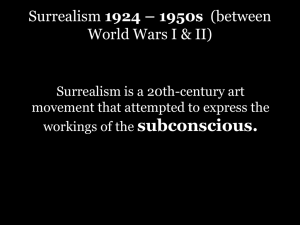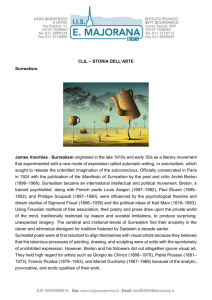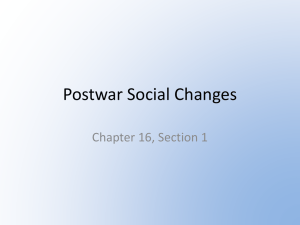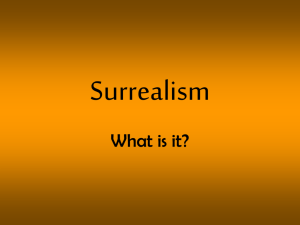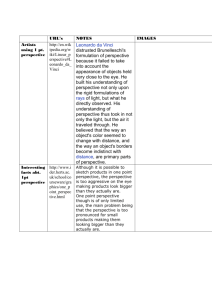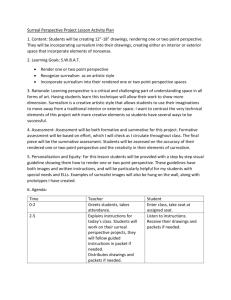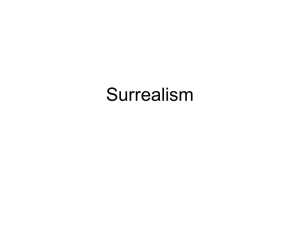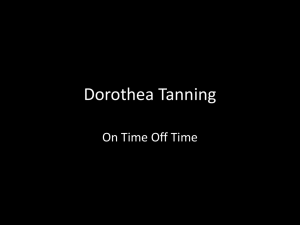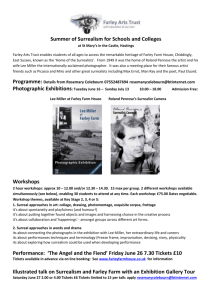Document
advertisement
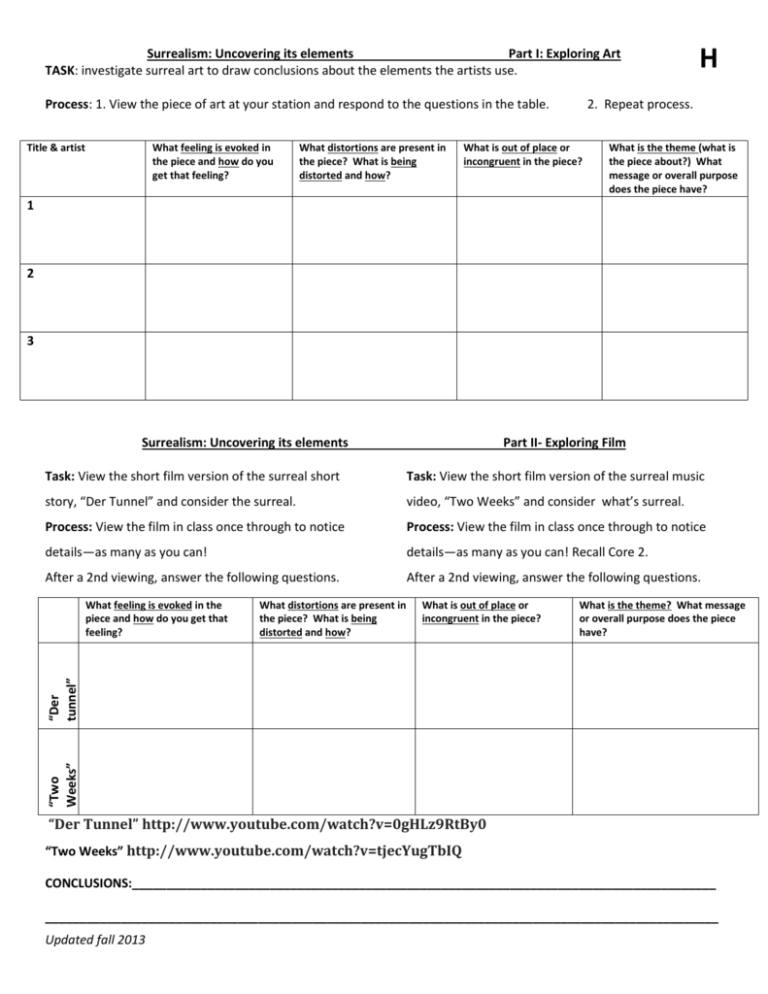
Surrealism: Uncovering its elements Part I: Exploring Art TASK: investigate surreal art to draw conclusions about the elements the artists use. Process: 1. View the piece of art at your station and respond to the questions in the table. Title & artist What feeling is evoked in the piece and how do you get that feeling? What distortions are present in the piece? What is being distorted and how? H 2. Repeat process. What is out of place or incongruent in the piece? What is the theme (what is the piece about?) What message or overall purpose does the piece have? 1 2 3 Surrealism: Uncovering its elements Part II- Exploring Film Task: View the short film version of the surreal short Task: View the short film version of the surreal music story, “Der Tunnel” and consider the surreal. video, “Two Weeks” and consider what’s surreal. Process: View the film in class once through to notice Process: View the film in class once through to notice details—as many as you can! details—as many as you can! Recall Core 2. After a 2nd viewing, answer the following questions. After a 2nd viewing, answer the following questions. What distortions are present in the piece? What is being distorted and how? What is out of place or incongruent in the piece? What is the theme? What message or overall purpose does the piece have? “Two Weeks” “Der tunnel” What feeling is evoked in the piece and how do you get that feeling? “Der Tunnel” http://www.youtube.com/watch?v=0gHLz9RtBy0 “Two Weeks” http://www.youtube.com/watch?v=tjecYugTbIQ CONCLUSIONS:_____________________________________________________________________________________ __________________________________________________________________________________________________ Updated fall 2013 Surrealism: Uncovering its elements Part III- Defining Surrealism TASK: Use the entry provided to compose your own definition to use in the unit. PROCESS: when you’re reading, annotate for key concepts, people, dates, events, and principles/goals—pick your own colors and or symbols to code what you’re underlining. “Surrealism” from The Oxford Dictionary of Western Art SURREALISM, an artistic and literary movement, founded in Paris in 1924, whose influence extended for several decades throughout Europe and the Americas. Surrealism was created by a group of Parisian intellectuals, led by poet Andre Breton, who had previously been involved in Dada. The new movement inherited certain of Dada’s qualities, including its revolutionary political stance and contempt for cultural conventions, as well as its use of chance in the production of collages and poems. However, while Dada had intended to subvert the concept of artistic creativity, Surrealism had a more positive aim, seeking to fuse the conventional, logical view of reality with unconscious, dream experience in order to achieve a ‘super-reality’. This phrase led to the adoption of the term ‘surrealisme,’ which had in fact been coined by the poet Guillaume Apollinaire in 1917. The Surrealists cited a wide range of precursors, ranging from the poets Arthur Rimbaud and Count de Lautreamont, to earlier artists such as Arcimcoldo, Piranesi, Bosch, Goya, Felicien Rops and Odilon Redon, as well as to their contemporaries Marc Chagall and Georgia de Chirico. They were also preoccupied with Freudian psychoanalysis, and as a result concentrated initially on expressing the workings of the unconscious mind through the technique of automatism: drawing or writing executed without any conscious control. Indeed Breton’s First Surrealist Manifesto (1924) defines Surrealism as ‘pure psychic automatism, by which it is intended to express, verbally, in writing, or by other means, the real process of thought. Thought’s dictation, in the absence of all control exercised by reason and outside of all aesthetic or moral preoccupations…Surrealism rests in the belief in the superior reality of certain forms of associations neglected heretofore; in the omnipotence of the dream, and in the disinterested play of thought.’ Breton was affected by the rising field of psychoanalysis, which explored human behavior and its roots in experience. The dream world was thought to be deeply rooted in the subconscious, making the dream the most powerful and truest representation of the self. While Breton’s definition refers primarily to verbal and literary activity, such as the poems of Paul Eluard and Breton himself, automatism was also practiced by such artists as Hans Arp, Andre Masson, and Miro. Masson’s work included sand paintings, in which sand was poured on glue-covered canvases, creating arbitrary patterns which then suggested to the artist a subject (usually violent or erotic). Max Ernst also developed procedures based on chance through the invention of frottage and grattage, the latter technique involving the scraping away of upper layers of paint so as to reveal unexpected forms in the under-layers. Ernst also later practiced ‘decalcomania,’ a process developed by Oscar Dominguez around 1950, which involved rubbing paint arbitrarily between two sheets of paper. Despite these developments, the decline of automatism as a Surrealist technique can be perceived as early as 1930, the date of the Second Surrealist Manifesto. By the time such painters as Tanguy, Magrite, and Dali were attempting to explore the unconscious in highly contrived dreamlike paintings, executed with the skill of the academic painter. Together these works combined the reproduction of dream settings with suitably irrational juxtapositions of apparently unrelated objects. Throughout the history of surrealism, an important role was played by sculpture. Most surrealists also experimented with objet trouve, producing unsettling, illogical combinations of objects divorced from their normal settings and functions. The Surrealist’s bizarre juxtapositions also demonstrated the concept of beauty as ‘the chance encounter of a sewing machine and an umbrella on an operating table.’ These objects were also seen as materializing their creators’ unconscious desires, which would then be communicated to the spectator, so as to stimulate his own imagination. While such avant-garde innovations were coolly received by the surrealists’ supposed allies in the Communist Party, Breton and his colleagues organized hugely successful exhibitions in other Western countries. Moreover, during the Second World War, American artists were strongly influenced by Surrealist émigrés in New York. Although the disruption of the war effectively destroyed Surrealism as a coherent movement, individual Surrealists continued to work far into the post-war period. Surrealism remains unquestionably on of the most significant phenomena in 20th-century art through its expression of the unconscious, and emphasis on the marvelous and fantastic in contrast to the purely formal consideration of other contemporary movements. NOTE: when you turn your annotations into notes, you should use a separate sheet of paper. You can use ONLY those notes on the surrealism quiz. Surrealism: Uncovering its elements Part IV- pre-Reading “If you were a tree, what kind of tree would you be?” James Lipton Inside the Actor’s Studio Task: consider what kind of animal you would be and justify it based on what you know of the animal’s characteristics. Process: Think for a few minutes about what kind of animal or insect YOU would most likely be and compose a wellwritten explanation with characteristics and examples to justify that claim. Start by thinking of your qualities— environments, sleeping, eating, living habits, groupings, lifestyle, etc. Be honest! We’d all like to be jaguars, but some of us really are three-toed sloths. If you’re stumped for animals, see the PPt in class and think of there are any connections. Product: You should type and print a well-reasoned paragraph where you introduce your animal self and the qualities IT has that exemplify YOUR personality (ex. Fish live in schools, and you’re never alone, because you’re very social). You should have at least 7 things that you share. Surrealism: Uncovering its elements Part V- exploring The Metamorphosis TASK: find as many examples of surrealism as possible in Chapter 1 while and/or after you read noting the page number AND explaining its surrealist value (recall our terms from our pre-reading investigation: distortion, incongruity, subconscious AKA “real”, dreamlike.) Brief explanation of incident/scene Updated fall 2013 Pg # Surreal Quality NOW In a well-written paragraph, describe how the surrealism in the 1st chapter affects the story as whole. Consider the following questions to prompt your response. DO NOT simply answer these questions. MAKE the answers to these questions part of your overall response. How do the surreal elements change the feel of the story? How do the surreal elements change the way we as readers perceive or understand the characters? What doe the surreal elements make us think about where the plot is going to take us based on the opening chapter? __________________________________________________________________________________________________ __________________________________________________________________________________________________ __________________________________________________________________________________________________ __________________________________________________________________________________________________ __________________________________________________________________________________________________ __________________________________________________________________________________________________ __________________________________________________________________________________________________ __________________________________________________________________________________________________ __________________________________________________________________________________________________ __________________________________________________________________________________________________ __________________________________________________________________________________________________ __________________________________________________________________________________________________ Updated fall 2013
